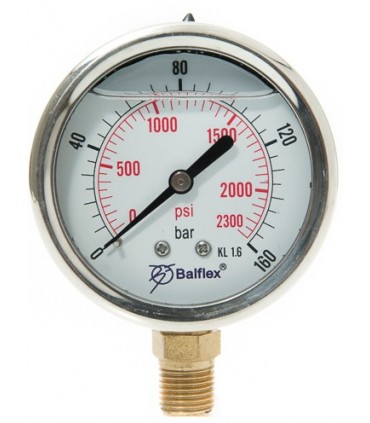- Case material: SS / ABS / Steel painted
- Bar: 7/10/16/25/40/60/100/250/300/400/500/700
- Case Size – 63mm / 40mm / 53mm / 100mm
- Filling : Glycerin / Dry
- Connection : 1 – brass 1/4” – / 1/2” – 1/8” NPT / BSPP down / middle back
Pressure gauges are essential instruments used to measure and display the pressure of a fluid (liquid or gas) in a system. They are widely employed across various industries to monitor and control pressure levels in equipment and processes. Here’s a comprehensive overview of pressure gauges:
Function of Pressure Gauges:
Pressure gauges serve the following key functions:
- Pressure Measurement:
- The primary function of a pressure gauge is to measure and indicate the pressure exerted by a fluid within a closed system. This measurement is typically displayed in units such as pounds per square inch (psi), bar, kilopascal (kPa), or atmospheres (atm).
- Monitoring and Control:
- Pressure gauges are used to monitor pressure levels in machinery, pipelines, tanks, and other equipment. This helps operators ensure that systems operate within safe and efficient pressure ranges.
- Safety and Protection:
- By providing real-time pressure readings, gauges help prevent overpressure situations that could lead to equipment failure, leaks, or other hazards.
Types of Pressure Gauges:
- Analog/Dial Gauges:
- These are traditional pressure gauges with a circular dial display and a pointer indicating the pressure value. Analog gauges are widely used for general pressure measurement applications.
- Digital Gauges:
- Digital pressure gauges provide a numeric display of pressure values, offering precise readings with digital accuracy. They often feature additional capabilities such as data logging and customizable units.
- Absolute Pressure Gauges:
- Measure pressure relative to a perfect vacuum (zero pressure). Commonly used in applications where the reference point is absolute zero pressure.
- Gauge Pressure Gauges:
- Measure pressure relative to atmospheric pressure (zero reference point). Most common type used in industrial applications.
- Differential Pressure Gauges:
- Measure the difference in pressure between two points within a system. Useful for flow measurement and filter monitoring.
Components of Pressure Gauges:
- Dial Face:
- The circular display where pressure readings are indicated by a pointer.
- Pointer:
- The needle or pointer on the dial that moves to indicate the current pressure.
- Pressure Element:
- The internal mechanism that converts applied pressure into mechanical movement, typically using a bourdon tube, diaphragm, or bellows.
- Case and Bezel:
- The housing that encloses the internal components of the gauge, providing protection against environmental factors.
- Connection Ports:
- Inlets and outlets for connecting the gauge to the system where pressure is being measured.
Applications of Pressure Gauges:
Pressure gauges are used in numerous industries and applications, including:
- Manufacturing: Monitoring pressure in hydraulic and pneumatic systems.
- Oil and Gas: Wellhead monitoring, pipeline pressure measurement.
- Chemical Processing: Pressure measurement in reactors, vessels, and distillation columns.
- HVAC Systems: Monitoring pressure in air handling units and refrigeration systems.
- Water Treatment: Pressure monitoring in pumps, filters, and water distribution networks.
Selection Considerations:
When selecting a pressure gauge, consider the following factors:
- Pressure Range: Ensure the gauge’s range matches the expected pressure levels within the system.
- Accuracy: Choose a gauge with appropriate accuracy for the application.
- Environment: Select gauges with suitable materials and enclosures for the operating environment (e.g., corrosive atmospheres, high temperatures).
Conclusion
Pressure gauges are indispensable instruments for measuring, monitoring, and controlling pressure in industrial processes and equipment. By providing accurate pressure readings, these gauges contribute to the safety, efficiency, and reliability of various systems.


